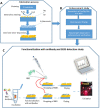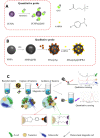Recent advances of Au@Ag core-shell SERS-based biosensors
- PMID: 37323623
- PMCID: PMC10190953
- DOI: 10.1002/EXP.20220072
Recent advances of Au@Ag core-shell SERS-based biosensors
Abstract
The methodological advancements in surface-enhanced Raman scattering (SERS) technique with nanoscale materials based on noble metals, Au, Ag, and their bimetallic alloy Au-Ag, has enabled the highly efficient sensing of chemical and biological molecules at very low concentration values. By employing the innovative various type of Au, Ag nanoparticles and especially, high efficiency Au@Ag alloy nanomaterials as substrate in SERS based biosensors have revolutionized the detection of biological components including; proteins, antigens antibodies complex, circulating tumor cells, DNA, and RNA (miRNA), etc. This review is about SERS-based Au/Ag bimetallic biosensors and their Raman enhanced activity by focusing on different factors related to them. The emphasis of this research is to describe the recent developments in this field and conceptual advancements behind them. Furthermore, in this article we apex the understanding of impact by variation in basic features like effects of size, shape varying lengths, thickness of core-shell and their influence of large-scale magnitude and morphology. Moreover, the detailed information about recent biological applications based on these core-shell noble metals, importantly detection of receptor binding domain (RBD) protein of COVID-19 is provided.
Keywords: Au@Ag core–shell nanoparticles; SERS probes; biosensors.
© 2023 The Authors. Exploration published by Henan University and John Wiley & Sons Australia, Ltd.
Conflict of interest statement
Aiguo Wu is a member of the Exploration editorial board. The other authors declare no conflict of interest.
Figures














Similar articles
-
The structural transition of bimetallic Ag-Au from core/shell to alloy and SERS application.RSC Adv. 2020 Jun 29;10(41):24577-24594. doi: 10.1039/d0ra04132g. eCollection 2020 Jun 24. RSC Adv. 2020. PMID: 35516184 Free PMC article.
-
Functionalized Au@Ag-Au nanoparticles as an optical and SERS dual probe for lateral flow sensing.Anal Bioanal Chem. 2018 Mar;410(9):2291-2303. doi: 10.1007/s00216-018-0850-z. Epub 2018 Feb 14. Anal Bioanal Chem. 2018. PMID: 29445833
-
Ultrasensitive detection of thiram based on surface-enhanced Raman scattering via Au@Ag@Ag core/shell/shell bimetallic nanorods.Analyst. 2023 Oct 23;148(21):5435-5444. doi: 10.1039/d3an00821e. Analyst. 2023. PMID: 37750326
-
Growth of Spherical Gold Satellites on the Surface of Au@Ag@SiO2 Core-Shell Nanostructures Used for an Ultrasensitive SERS Immunoassay of Alpha-Fetoprotein.ACS Appl Mater Interfaces. 2019 Jan 23;11(3):3617-3626. doi: 10.1021/acsami.8b21238. Epub 2019 Jan 11. ACS Appl Mater Interfaces. 2019. PMID: 30608142
-
Development and Biomedical Application of Non-Noble Metal Nanomaterials in SERS.Nanomaterials (Basel). 2024 Oct 15;14(20):1654. doi: 10.3390/nano14201654. Nanomaterials (Basel). 2024. PMID: 39452990 Free PMC article. Review.
Cited by
-
Synthesis of Composition-Tunable Ag-Cu Bimetallic Nanoparticles Through Plasma-Driven Solution Electrolysis.Nanomaterials (Basel). 2024 Oct 31;14(21):1758. doi: 10.3390/nano14211758. Nanomaterials (Basel). 2024. PMID: 39513838 Free PMC article.
-
Applications of Lignin-Dervied Carbon Quantum Dots: Current Status and Challenges.Exploration (Beijing). 2025 Apr 17;5(3):70039. doi: 10.1002/EXP.70039. eCollection 2025 Jun. Exploration (Beijing). 2025. PMID: 40585772 Free PMC article. Review.
-
Detection of micro- and nanoplastic particles in leafy green vegetables by SERS coupled with gold-silver core-shell nanoparticles.Mikrochim Acta. 2024 Nov 23;191(12):755. doi: 10.1007/s00604-024-06836-w. Mikrochim Acta. 2024. PMID: 39579227
-
Surface-Modified Nanozymes for Enhanced and Selective Catalysis.ACS Appl Mater Interfaces. 2025 Aug 6;17(31):44011-44029. doi: 10.1021/acsami.5c07647. Epub 2025 Jul 23. ACS Appl Mater Interfaces. 2025. PMID: 40698926 Free PMC article. Review.
-
Au-Ag Bimetallic Nanoparticles for Surface-Enhanced Raman Scattering (SERS) Detection of Food Contaminants: A Review.Foods. 2025 Jun 16;14(12):2109. doi: 10.3390/foods14122109. Foods. 2025. PMID: 40565718 Free PMC article. Review.
References
-
- Langer J., De Aberasturi D. J., Aizpurua J., Alvarez‐Puebla R. A., Auguié B., Baumberg J. J., Bazan G. C., Bell S. E., Boisen A., Brolo A. G., Choo J., Cialla‐May D., Deckert V., Fabris L., Faulds K., de Abajo F. J. G., Goodacre R., Graham D., Haes A. J., Haynes C. L., Huck C., Itoh T., Käll M., Kneipp J., Kotov N. A., Kuang H., Le Ru E. C., Lee H. K., Li J.‐F., Yi Ling X., Maier S. A., et al., ACS Nano 2019, 14, 28. - PubMed
-
- Wu D., Chen Y., Hou S., Fang W., Duan H., ChemBioChem 2019, 20, 2432. - PubMed
-
- Chen H., Park S. G., Choi N., Moon J. I., Dang H., Das A., Lee S., Kim D. G., Chen L., Choo J., Biosens. Bioelectron. 2020, 167, 112496. - PubMed
-
- Rastogi R., Arianfard H., Moss D., Juodkazis S., Adam P. M., Krishnamoorthy S., ACS Appl. Mater. Interfaces 2021, 13, 9113. - PubMed
Publication types
LinkOut - more resources
Full Text Sources
Miscellaneous
